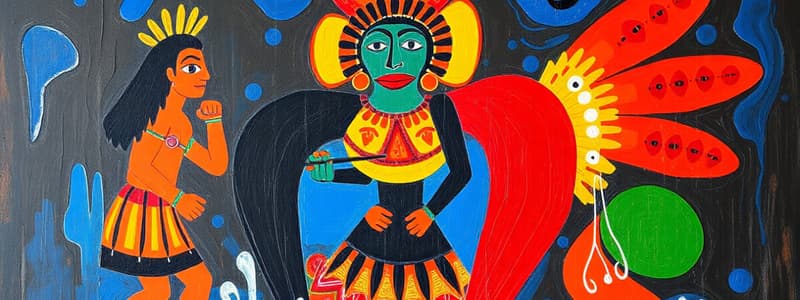Podcast
Questions and Answers
What is the primary significance of Aong Tabon for the indigenous people of the Philippines?
What is the primary significance of Aong Tabon for the indigenous people of the Philippines?
- It is linked to ancestral heritage. (correct)
- It serves as a major tourist attraction.
- It represents agricultural development.
- It is a site for modern religious practices.
Which belief system is commonly found among indigenous groups, as indicated in the content?
Which belief system is commonly found among indigenous groups, as indicated in the content?
- Polytheism
- Animism (correct)
- Buddhism
- Monotheism
How do indigenous beliefs typically view the land?
How do indigenous beliefs typically view the land?
- As an economic resource to be exploited.
- As a mere physical space without spiritual significance.
- As a living entity with spiritual significance. (correct)
- As an object for private ownership.
What role do elders play in the indigenous communities related to Aong Tabon?
What role do elders play in the indigenous communities related to Aong Tabon?
What aspect of community life do indigenous beliefs emphasize?
What aspect of community life do indigenous beliefs emphasize?
Flashcards are hidden until you start studying
Study Notes
Aong Tabon: Indigenous Beliefs
-
Cultural Significance
- Aong Tabon is a crucial site for the indigenous people of the Philippines, particularly the Tabon Man.
- It is located in the Tabon Caves in Palawan and is linked to ancestral heritage.
-
Creation Myths
- Indigenous beliefs often include creation stories explaining the origins of the universe and humanity.
- The Tabon Man is sometimes viewed as a symbol of the earliest human presence in the region.
-
Spiritual Practices
- Rituals and ceremonies are held to honor ancestors and spirits.
- Nature is revered; mountains, rivers, and animals are seen as sacred elements of life.
-
Connection to the Land
- The indigenous peoples’ beliefs emphasize a profound connection to their land, which is seen as a source of identity and spirituality.
- Land is not just a physical space but also a living entity with spiritual significance.
-
Animism
- Many indigenous groups practice animism, believing that spirits inhabit natural objects and places.
- This belief fosters a sense of respect and stewardship for the environment.
-
Oral Traditions
- Knowledge and beliefs are passed down orally through stories, songs, and legends.
- Elders play a vital role in teaching younger generations about their cultural heritage.
-
Community and Kinship
- Indigenous beliefs often emphasize communal living and the importance of family and kinship ties.
- Community gatherings for rituals strengthen social cohesion and cultural identity.
-
Resistance and Resilience
- Indigenous beliefs have persisted despite colonization and modernization, symbolizing resilience.
- Contemporary movements often blend traditional beliefs with current issues, advocating for indigenous rights.
These points encapsulate the indigenous beliefs associated with Aong Tabon, highlighting their cultural significance, spiritual practices, and connection to the environment.
Cultural Significance
- Aong Tabon holds immense importance for the indigenous people of the Philippines, particularly as it is associated with the Tabon Man.
- Located in the Tabon Caves of Palawan, Aong Tabon represents vital ancestral heritage and identity.
Creation Myths
- Indigenous beliefs encompass various creation stories that elucidate the origins of the universe and humanity.
- The Tabon Man symbolizes the earliest known human presence in the region, linking modern identities to ancient ancestry.
Spiritual Practices
- Rituals and ceremonies are vital for honoring ancestors and spiritual entities, establishing a connection with the past.
- Natural elements such as mountains, rivers, and animals are regarded as sacred, reflecting the deep respect for nature within these belief systems.
Connection to the Land
- Indigenous peoples share a profound connection to their land, viewing it as a central aspect of their identity and spirituality.
- The land is perceived not merely as a physical space but as a living entity holding significant spiritual value.
Animism
- Many indigenous communities practice animism, attributing spirits to natural objects and locations, deepening their relationship with the environment.
- This belief fosters respect and a stewardship mentality towards nature, encouraging sustainable practices and conservation.
Oral Traditions
- Knowledge and cultural beliefs are transmitted orally through stories, songs, and legends, fostering a rich tradition of education.
- Elders play a critical role in teaching younger generations, ensuring the continuity of cultural heritage and identity.
Community and Kinship
- Communal living and strong family ties are emphasized in indigenous beliefs, nurturing social cohesion within communities.
- Participation in communal rituals reinforces collective cultural identity and belonging among members.
Resistance and Resilience
- Despite challenges posed by colonization and modernization, indigenous beliefs have shown resilience, adapting over time while retaining core tenets.
- Contemporary movements increasingly blend traditional beliefs with current social issues, advocating for indigenous rights and preserving cultural integrity.
Studying That Suits You
Use AI to generate personalized quizzes and flashcards to suit your learning preferences.
